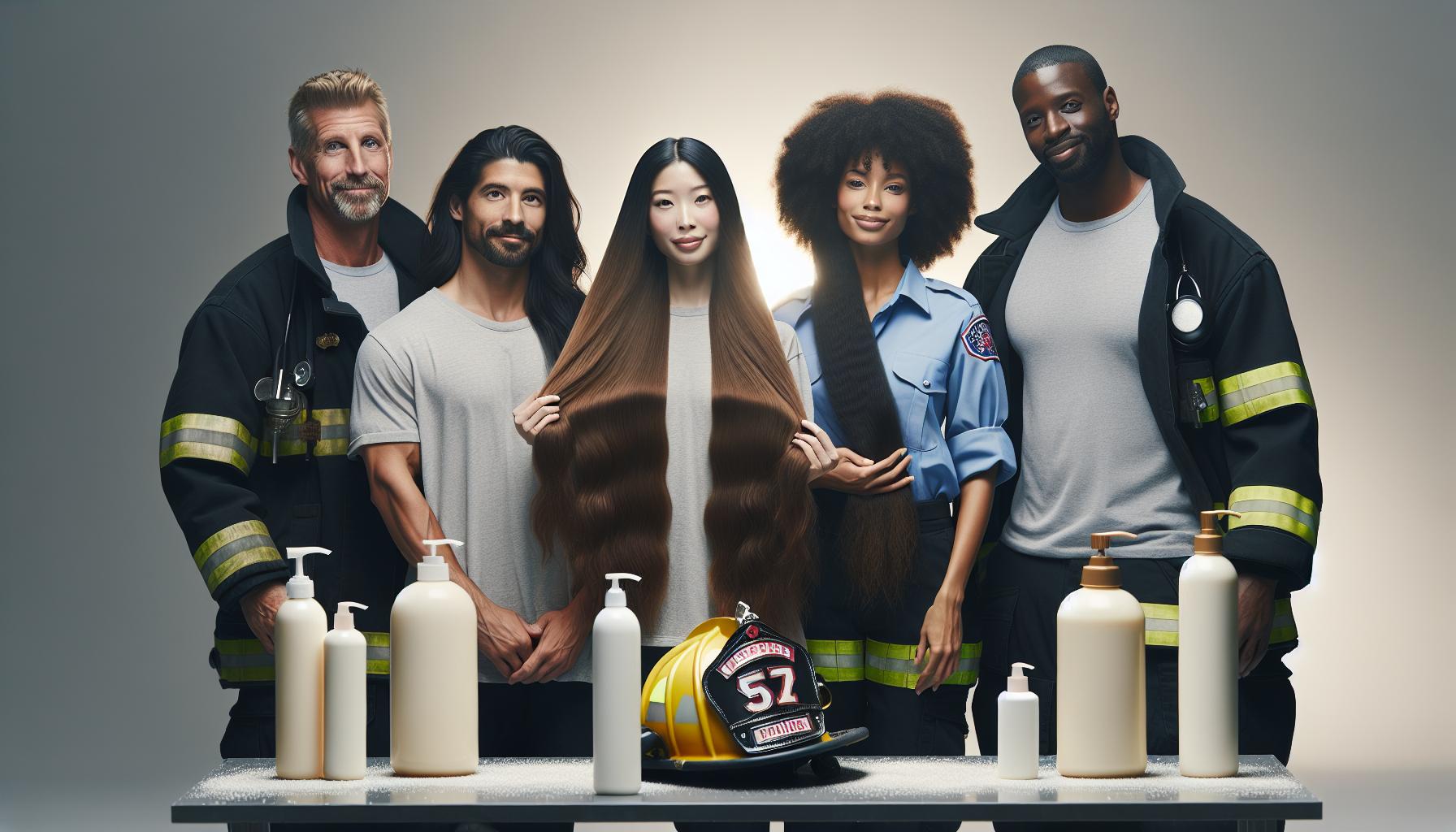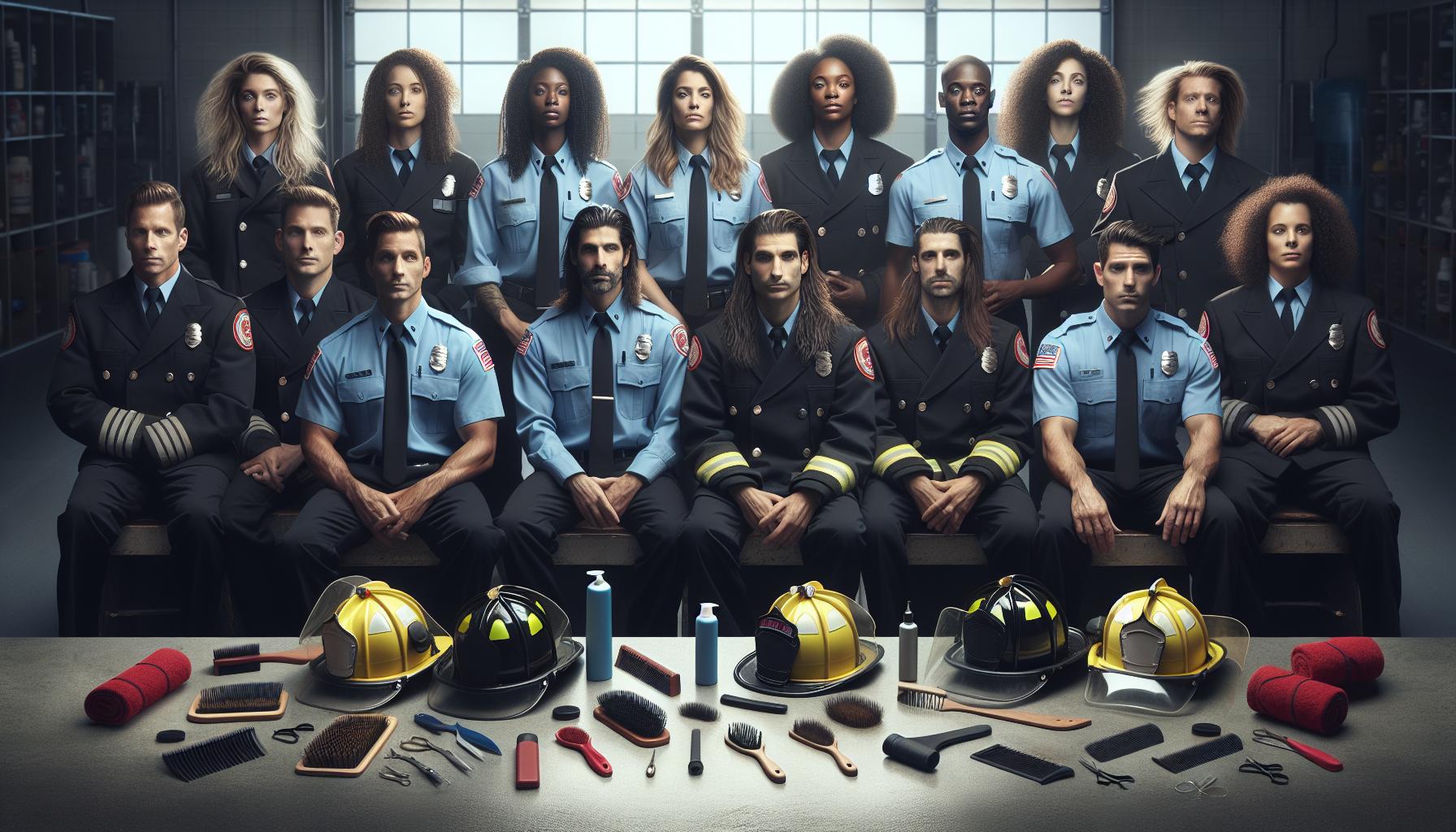Can firefighters maintain long hair while ensuring safety on the job? This question sparks debate in the firefighting community, as hair can pose risks in high-stress environments. Understanding the safety regulations and hearing real-life accounts can shed light on this issue, helping to balance personal expression with professional duty.
Contents
- Understanding the Safety Considerations of Long Hair for Firefighters
- Personal Experiences: Firefighters Share Their Long Hair Journeys
- Grooming Standards: What’s Appropriate for Firefighting Professionals?
- Practical Tips for Managing Long Hair in High-Risk Environments
- The Balance Between Expression and Safety: Hair Policy Insights
- Real-Life Scenarios: How Long Hair Has Impacted Emergency Responses
- Expert Opinions: Fire Chiefs Weigh In on Hair Regulations
- Supporting Firefighters’ Choices: Resources for Hair Care and Maintenance
- Q&A
- Can firefighters have long hair?
- What are the safety rules for firefighters with long hair?
- Can I be a firefighter if I have long hair?
- Why does hair length matter for firefighters?
- Are there real stories about firefighters with long hair?
- What should I no about hair care as a firefighter?
- Can firefighters wear hats or other accessories with long hair?
- In Summary
Understanding the Safety Considerations of Long Hair for Firefighters
Firefighting is one of the most risky professions, demanding not only physical strength and agility but also a keen awareness of safety protocols. as a firefighter,every detail counts,including your hairstyle. While many might wonder whether firefighters can have long hair, the answer is more complex than a simple yes or no. Understanding the implications of long hair on safety is crucial for both new recruits and experienced personnel.
Potential Hazards of Long Hair in Firefighting
Long hair can pose several hazards in emergency situations. When battling blazes or navigating through smoke-filled environments, loose strands can become entangled in equipment or obstruct a firefighter’s vision. This distraction can lead to dangerous missteps or hinder effective use of gear, such as oxygen masks. It’s essential to recognize these risks to prioritize safety.
Here are some specific concerns regarding long hair for firefighters:
- flammability: Hair can catch fire easily in extreme heat conditions.
- Tangles: Long hair may get caught in machinery or hoses, potentially pulling a firefighter into unsafe situations.
- Obstruction: Uncontrolled hair can obscure visibility or interfere with the proper sealing of PPE (personal protective equipment).
- Lack of Control: Hair may impede swift head movements required during rescue operations.
Recommendations for Firefighters with Long Hair
To mitigate these risks, firefighters with long hair must adopt best practices that enhance safety without compromising their ability to perform. Here are practical steps:
- Secure your Hair: Use tight buns,braids,or ponytails to keep hair off the face and neck.
- Use Protective Gear: Fire-resistant hats or helmets can help secure long hair and protect from heat.
- Regular Training: Engage in simulations to understand how hair can affect movement and functionality under stress.
- Consult Policies: Always check departmental guidelines regarding hair regulations, as they may specify acceptable styles for safety reasons.
Real-World Insights
Many firefighters with long hair share success stories demonstrating that with the right precautions, it can be manageable in the field. As an example, one firefighter recounts their experience during a wildfire, stating how securing their hair properly made a important difference in their ability to wear a respirator effectively while battling flames. Such real-world experiences highlight that while long hair may introduce certain challenges, thoughtful management can mitigate potential hazards.
A summary of insights on this topic would be incomplete without mentioning how fire departments across the country have started to adapt their policies regarding personal grooming, recognizing the evolving nature of firefighting culture while still prioritizing safety. Long hair does not have to be an impediment if firefighters take the proper steps to ensure it remains controlled and safe during operations.
As discussions around grooming standards in emergency services evolve, many firefighters are stepping forward to share their personal journeys regarding long hair. These narratives not only reflect individual choices but also illustrate the intersection of personal expression and safety in a profession traditionally bound by strict guidelines.
Voices from the Firehouse
The experiences of firefighters with long hair are varied and deeply personal. here are some highlights from their unique stories:
- Emily, Boston Fire Department: After years of keeping her hair short to comply with department regulations, Emily decided to grow her hair out. She emphasizes the importance of safety, stating, “I always tie my hair back during calls. It’s essential to maintain visibility and avoid any potential hazards.” For her, long hair represents a way to challenge stereotypes while maintaining professionalism.
- James, Los Angeles Fire Department: For James, growing his hair long was a personal choice tied to cultural expression. “When I joined the force, I faced scrutiny for my long hair,” he recalls. “However, I worked with my department to establish guidelines that ensured safety without compromising my identity. Now, I secure my hair with a professional-style bun and wear a helmet, allowing me to do my job effectively while staying true to myself.”
- Samantha, Chicago Fire Department: Samantha’s journey began with a simple quest to donate her hair. She shared her process: “Not only do I love my long hair,but I also contribute to a good cause. I ensure it’s always tied up and tucked away when on duty. Safety comes first, but so does making a statement.”
finding the Balance
While individual stories vary, a common thread is the understanding that long hair can be compatible with safety protocols in firefighting. Many departments are adjusting their policies to embrace diversity while ensuring that first responders remain unencumbered by their personal choices.
Key Considerations for Firefighters with Long Hair:
| consideration | Description |
|---|---|
| Secure tying | Always tie back hair in a tight bun or braid to avoid interference during fire response. |
| Use of Protective Gear | Ensure that your helmet fits securely, allowing no room for hair to become entangled. |
| Regular Maintenance | Regularly trim and care for your hair to prevent it from becoming damaged or unmanageable while on duty. |
| Informed Dialog | Engage with recruitment and leadership about personal policies on hair to foster understanding and potential adjustments. |
These shared experiences underscore that long hair does not inherently conflict with safety standards. By fostering a culture of understanding and open dialogue, firefighters can pave the way for a more inclusive habitat while adhering to essential safety measures.
Grooming Standards: What’s Appropriate for Firefighting Professionals?
Throughout their demanding careers, firefighters must adhere to specific grooming standards that not only promote professionalism but also prioritize safety. The question often arises: can firefighters have long hair? While personal style is vital,the nature of firefighting requires that grooming choices do not compromise safety or functionality. Understanding the balance between individuality and safety standards is essential for every firefighter.
Safety First: The Implications of Long Hair
Long hair can pose several risks in environments were exposure to heat, chemicals, and fire is prevalent. If not secured properly, it can easily become entangled in equipment, obstruct vision, or even ignite. To illustrate the importance of adhering to grooming standards, here are some critical considerations:
- Secured Hair: Hair should always be tied back and secured in a way that minimizes risk. Braids, buns, or ponytails are practical options that keep hair away from the face and neck.
- Protective gear Compatibility: Firefighters wear specific protective gear, including helmets that must fit snugly. Long hair not properly secured can interfere with the effectiveness of this gear.
- Hygiene and professionalism: Clean and well-groomed appearances reflect a commitment to the profession and help foster trust within the community served.
Real Stories Highlighting the Importance of Grooming Standards
Across the country,numerous firefighters have shared their experiences concerning grooming standards.As an example, a firefighter from California recounted an incident during a training exercise where his long hair, despite being tied back, momentarily obstructed his peripheral vision as he navigated through smoke-filled conditions. This potentially dangerous situation underscored the need for strict grooming regulations.
| Firefighter Story | Lesson Learned |
|---|---|
| California firefighter’s training incident | Importance of hair management for visibility and control |
| New York City firefighter escape | Long hair could impede evacuation efforts |
embracing a professional grooming standard is vital for all firefighting professionals, and this includes understanding the implications of personal grooming choices. While hair length may seem like a trivial matter,its impact on safety and effectiveness in the line of duty cannot be overlooked. By following established guidelines, firefighters can ensure they remain safe and effective while honoring their individual styles within the boundaries of their profession.
Practical Tips for Managing Long Hair in High-Risk Environments
Long hair can be a stunning aspect of personal expression, yet in high-risk environments, such as firefighting, it poses unique challenges that require careful management. For those in the profession wondering, “Can firefighters have long hair?” it’s crucial to understand that while it is indeed possible, safety must always come first. Here are some practical tips to keep long hair safe and manageable while adhering to both safety regulations and personal preference.
Secure Your Hair Effectively
When working in environments where sudden movements or potential hazards are present, securing long hair properly is essential. Consider these methods to ensure your hair stays out of the way:
- Braid or Twist: Braiding or twisting hair can help keep it neatly tucked away, reducing the chance of tangling or getting caught.
- Use Hair Ties: Opt for strong, elastic hair ties that can withstand physical activity without breaking. Avoid metal clips that could become projectiles or cause injury.
- Protective Styles: Look into protective hairstyles that can be worn under helmets, such as buns or updos that fit snugly.
Invest in Safety Gear
Proper gear can make a significant difference when it comes to managing long hair in firefighting. Choose helmets and other protective equipment designed to accommodate longer hairstyles, allowing for both safety and comfort:
| Safety Gear | Benefits |
|---|---|
| Firefighting Helmet with Customizable Fit | Reduces movement and keeps hair secured, preventing distractions or hazards. |
| Fire-Resistant Hoods | Offers additional layer of protection while keeping hair tucked away and secure. |
| Heat-Resistant Hair Accessories | Prevents hair damage and provides secure attachment under helmets. |
Establish a Routine
Creating a reliable pre-shift routine can definitely help in managing long hair effectively. These habits can ensure that your hair is always controlled and protected before heading into high-risk situations:
- Pre-Shift Hair Prep: Set aside time to braid or secure your hair before shifts. this ensures you are always ready for action.
- Check Gear Fit: Regularly adjust helmet and gear fit to accommodate your hairstyle. A proper fit can prevent discomfort and distractions.
- Regular Maintenance: Keep hair healthy and manageable with regular trims and conditioning. Healthy hair is less likely to frizz or get caught when moving.
By implementing these practical tips,individuals with long hair can contribute to fire safety and maintain their personal style. Understanding how to balance elegance with safety will empower firefighters to confidently say, “Yes, I can have long hair,” while adhering to necesary safety rules.
The Balance Between Expression and Safety: Hair Policy Insights
When it comes to fighting fires, the stakes are incredibly high, and every aspect of a firefighter’s gear and appearance can impact safety. This is especially true when considering personal grooming standards, such as hair length and style. The debate surrounding whether firefighters can have long hair is multifaceted, intersecting personal expression with the uncompromising requirements of safety regulations. Understanding this balance is crucial, not just for those in the profession but also for the communities served.
Understanding Safety standards
Fire departments typically establish grooming policies that prioritize safety above all. These policies are designed with several key factors in mind:
- Gear Compatibility: Firefighters must wear helmets, masks, and other protective gear that should fit snugly. Long hair can interfere with the proper fit and effectiveness of these essential safety items.
- Fire Hazards: Loose hair poses a real risk in high-temperature environments. Long strands can easily catch on equipment or ignite from flames, leading to potentially life-threatening situations.
- Hygiene and Efficiency: In emergency situations, every second counts. Hair that could obstruct vision or require additional management can slow down a firefighter’s response time.
Despite these stringent safety measures, there are instances where departments have adopted more lenient approaches, allowing for long hair under specific conditions. Some departments enable certain styles,such as braids or tucked hair,wich meet safety requirements while accommodating personal expression.
Real Stories Highlighting the Balance
Individuals who have navigated these rules have shared their experiences, reflecting the tension between personal identity and professional duties. For example:
| Firefighter | Experience | Outcome |
|---|---|---|
| Emily Johnson | Had long hair that she kept in a bun, passed safety inspections | Allowed to work and promote personal style |
| Mark stevens | Chose to keep his hair short due to safety policies | Felt safer but missed expressing his individuality |
| Lisa Chen | participated in a new policy review for hair policies | Implemented accomplished changes that incorporated flexibility |
Through these real stories, it becomes clear that the intersection of personal expression and safety is a dynamic one. Each firefighter’s journey underscores the importance of open dialogue within fire departments about grooming standards, fostering an environment where safety and individuality can coexist.
while the question “Can firefighters have long hair?” may have a straightforward answer rooted in safety protocols, the real stories behind the regulations illustrate a narrative of adaptability and respect for the personal choices of those who dedicate their lives to service.
Real-Life Scenarios: How Long Hair Has Impacted Emergency Responses
While the debate surrounding personal grooming standards for firefighters frequently enough centers on safety and professionalism, the impact of long hair in emergency response scenarios cannot be overlooked. In the heat of a crisis, hair can become an unexpected hazard, potentially affecting both the firefighter’s safety and their ability to perform.
Challenges Faced in Emergency Situations
Long hair presents unique challenges during emergency responses. Here are some key issues that have arisen in real-life incidents:
- Visibility Hindrance: A firefighter with long hair may find their vision obstructed, especially if hair becomes disheveled or tangled during intense activities. This can lead to slower reaction times.
- Heat Management: The intense heat encountered in firefighting can cause long hair to trap warmth,leading to overheating. in such high-stress environments, efficient temperature regulation is crucial.
- Tangled Gear: Personal protective equipment (PPE) is designed to offer maximum safety, but long hair can become entangled in gear, complicating an already urgent situation.
Real-World Examples
several incidents illustrate how long hair can inadvertently impact emergency procedures.As an example, a firefighter responding to a structure fire found that her long hair had gotten caught in a fire hose. This not only caused a delay in her movement but also created a distraction that risked the safety of her team. In another case, a rescue operation at a road accident saw a male firefighter struggle with his hair getting stuck under his helmet, obscuring his focus while working under pressure.
Prioritizing Safety in Grooming Standards
To mitigate these risks, many fire departments enforce grooming standards that prioritize safety. Some of these guidelines include:
- Hair Restrictions: Keeping hair at a manageable length ensures that it doesn’t pose a hazard. Frequently enough, firefighters are required to have their hair tied back securely.
- Regular Training: Conducting training sessions to address the risks associated with long hair and other personal grooming choices can help firefighters remain aware of safety protocols.
- Peer Support: Creating a supportive environment where firefighters can discuss and adapt grooming standards based on personal experiences can lead to safer practices and more effective teamwork.
By understanding the real-life implications of long hair in firefighting, departments can develop clear rules that not only prioritize individual expression but also enhance overall safety and effectiveness in emergency responses.
Expert Opinions: Fire Chiefs Weigh In on Hair Regulations
When it comes to safety in firefighting, hair regulations can often spark heated debates. Many fire chiefs across the country have weighed in on the topic, particularly the question of whether firefighters can have long hair and the potential hazards it may pose. While some departments enforce strict grooming standards,others adopt a more flexible approach,focusing on practicality and safety over uniformity.
Safety First: Insights from Fire Chiefs
Fire chiefs emphasize that hair can be a safety concern if not managed properly. Long hair poses risks in various scenarios, such as fire suppression and rescue operations. Many fire chiefs share real-world insights regarding how long hair may obstruct vision, become caught in equipment or fire gear, or even pose a risk of catching fire itself. As an example:
- Chief Michael Johnson (New York City fire Department): ”In high-stress environments, visibility is critical. Long hair can hinder a firefighter’s ability to see clearly and react quickly.”
- Chief Lisa Martinez (Los Angeles Fire Department): “During incidents where we’re battling flames or navigating confined spaces, we prioritize safety. Hair management plays a pivotal role in that.”
Balancing Personal Expression and Professional Standards
Despite safety considerations, many fire chiefs advocate for a balanced approach that also respects individual expression. In discussions about hair regulations, the focus has shifted from strict rules to guidelines that allow for longer hair if properly secured. As an example:
| Department | Hair Policy | Comments |
|---|---|---|
| Chicago Fire Department | Long hair must be tied back neatly | Emphasizes safety without sacrificing individual style |
| Miami fire Department | Long hair allowed but must fit under helmet | Aim for safety with some flexibility |
| Seattle Fire Department | Strictly short hair for operational roles | Focus on uniformity and safety during emergencies |
Many fire chiefs believe that practical solutions can coexist with safety regulations. By engaging firefighters in conversations about grooming policies, departments can strike a balance that encourages personal expression while prioritizing the rigorous demands of their roles. This collaborative approach not only fosters a sense of community but also enhances overall safety in firefighting operations.
Supporting Firefighters’ Choices: Resources for Hair Care and Maintenance
When considering the unique challenges firefighters face, one often overlooked aspect is hair care and maintenance. Long hair can present specific safety hazards in this demanding profession, prompting many firefighters to seek practical solutions. Whether it’s to adhere to safety regulations or simply for personal preference, understanding how to manage long hair effectively is crucial for those dedicated to protecting lives and property.
To ensure that long hair remains manageable and safe, firefighters can explore several resources and strategies tailored for their specific needs. Below are some practical recommendations:
Hair Care Products and Tools
Investing in quality hair care products designed for active lifestyles can make a significant difference. Consider the following:
- Shampoos and conditioners: choose products that are hydrating and designed for strong,healthy hair to withstand frequent washing.
- Hair Ties and clips: use durable and high-quality hair ties that can securely hold hair without causing damage. Avoid metal clips that can break easily or pose a risk of snagging.
- Protective Oils or Sprays: These can provide an extra layer of defense against heat and environmental factors during training and rescue operations.
safe Styles for Firefighters
Maintaining hair safety while allowing for personal expression is crucial for firefighters with longer hair. Recommended hairstyles include:
- Braids: A side braid or a multiple-strand braid can keep hair contained and minimize entanglement during active duties.
- Buns: A secure bun positioned at the nape of the neck can offer a professional look while ensuring hair avoids contact with potentially hazardous equipment.
- Ponytails: Low ponytails can keep hair out of the way while still being easy to manage.
Essential Care Tips
To maintain healthy hair while facing the challenges of a firefighter’s lifestyle,consider these essential care tips:
| Tip | Description |
|---|---|
| Regular Trims | Keeping ends trimmed reduces split ends and maintains hair health. |
| Hydration | Use leave-in conditioners to maintain moisture, especially after exposure to heat and environmental stress. |
| Consult a Professional | Working with a hairstylist that understands the unique needs of first responders can provide tailored hair care solutions. |
| Monitor Hair Health | Pay attention to changes in hair texture or scalp health due to the demands of firefighting; adaptability is key. |
By embracing these strategies, firefighters can navigate the complexities of maintaining long hair while adhering to safety rules effectively. It reflects a commitment not only to their profession but also to self-care, demonstrating that personal grooming and safety can go hand in hand.
Q&A
Can firefighters have long hair?
Yes, firefighters can have long hair, but it must be properly secured and managed to adhere to safety regulations. This is important to prevent hair from getting caught in equipment or posing a hazard during emergencies.
The National Fire Protection Association (NFPA) suggests that long hair should be tied back or kept under a helmet during operations. This ensures that it does not obstruct vision or become a safety risk. in many fire departments, policies about hair length may vary, reflecting local safety rules and best practices.
What are the safety rules for firefighters with long hair?
Safety rules for firefighters with long hair typically require that hair be secured and out of the way during all firefighting activities. This minimizes the risk of hair entanglement and enhances the overall safety of the crew.
Common practices include using hair ties, caps, or even cut-resistant bands to ensure that long hair remains stable. Firefighters must also ensure that any safety gear fits correctly and is not hindered by loose hair, contributing to a safer working environment.
Can I be a firefighter if I have long hair?
Yes, you can be a firefighter with long hair, provided you follow the appropriate safety protocols. Many departments value diversity and individuality, provided that operational safety is maintained.
If you’re considering a firefighting career, it’s wise to check with your local department’s grooming policies. Some departments may have specific grooming standards, which could include hair length and style guidelines to ensure safety and professionalism.
Why does hair length matter for firefighters?
Hair length matters for firefighters primarily for safety and functionality reasons. Long hair can become a distraction or a safety hazard, potentially leading to injury if it gets caught in equipment.
Moreover, during high-stress situations, short, secure hairstyles can definitely help firefighters maintain focus and avoid unnecessary risks. Adequate grooming is part of a firefighter’s overall preparedness,which is crucial in emergencies.
Are there real stories about firefighters with long hair?
Yes, there are inspiring real stories of firefighters with long hair who have successfully navigated their careers. Many firefighters attribute their hair policies to personal choice and express how they manage their lengths responsibly on the job.
As a notable example, some share experiences where they used creative hair braids or styles that secured their hair while still adhering to safety standards. These stories emphasize the adaptability and commitment of firefighters to both their personal expression and their responsibilities.
What should I no about hair care as a firefighter?
As a firefighter, it’s essential to prioritize hair care, especially if you have long hair that might potentially be subjected to wear and tear. Regular maintenance, including washing and conditioning, is crucial to prevent damage from exposure to heat and debris.
Try using protective hairstyles and quality products to minimize breakage. Remember to consult with your department on specific hair care support; some firehouses provide resources that can definitely help firefighters manage their hair effectively while on duty.
Can firefighters wear hats or other accessories with long hair?
Firefighters can wear hats or accessories, but they must ensure that these do not compromise safety gear. Personal protective equipment should always remain the primary focus.
hats can help keep hair thermally protected during fires, while clips and ties can secure loose strands.Always check with your fire department’s specific policies regarding any equipment or accessory use.
In Summary
As we’ve explored in this article, the question of whether firefighters can have long hair is nuanced, touching on both safety regulations and personal expression.Firefighters frequently enough face strict guidelines concerning hair length to prioritize safety in hazardous environments, which is a crucial consideration for all professionals in this demanding field. Moreover, personal stories shared by firefighters resonate deeply, illustrating the balance between adhering to these rules and maintaining individual identity.
We encourage you to reflect on the practical solutions discussed, whether it’s learning to style your hair in a way that meets safety standards or considering options like protective hairstyles that lessen risk. Remember, the conversation around hair and safety is ongoing, and your voice matters. Engage with us further by sharing your thoughts or experiences related to hair care and safety. Let’s continue to explore this intersection of personal choice and professional requirements together!










